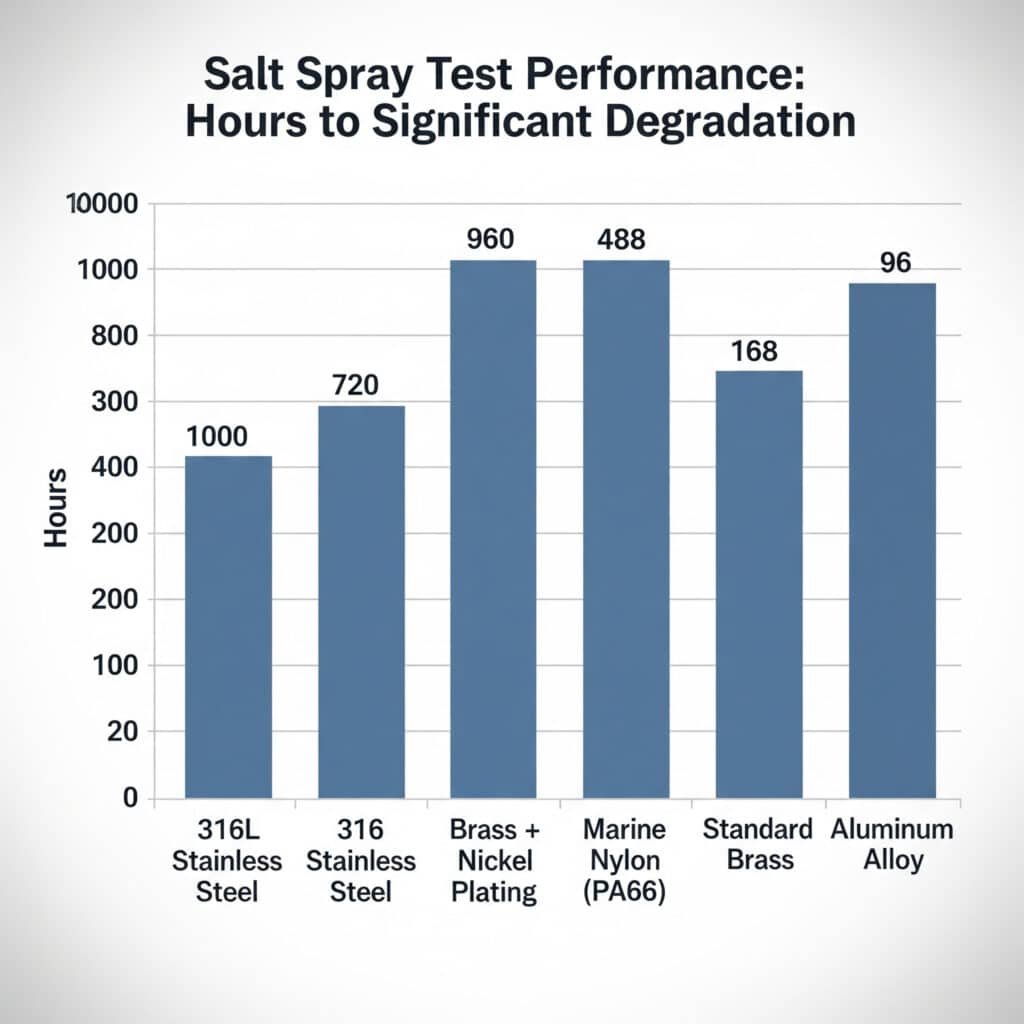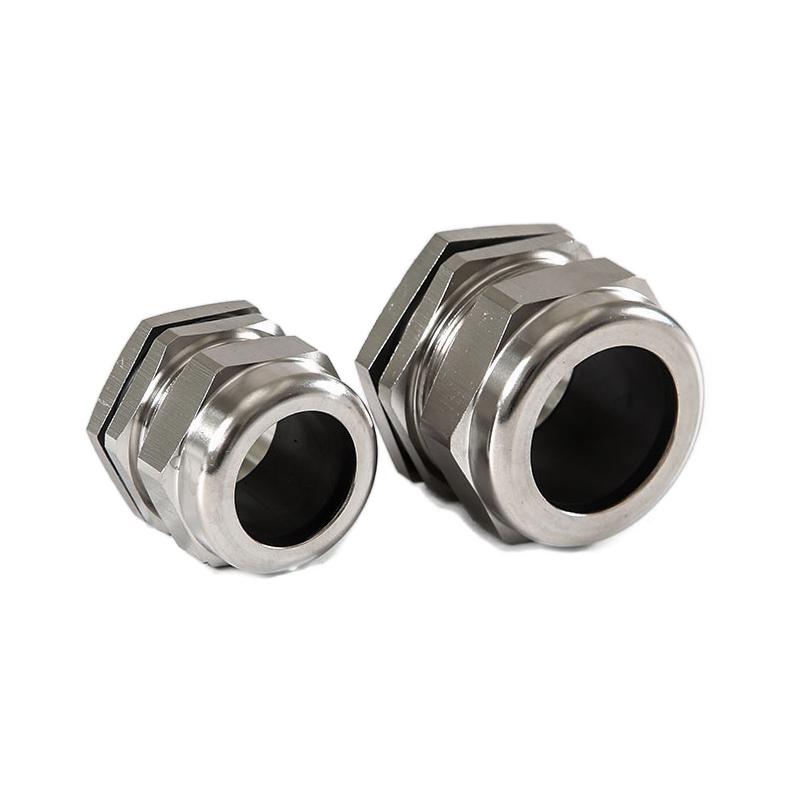Introduction
Picture this: You’ve just installed a critical electrical system at a coastal facility, only to discover six months later that your cable glands have corroded beyond recognition. The salt-laden air has turned your “marine-grade” components into rusty relics, threatening system integrity and safety. This nightmare scenario plays out more often than you’d think in coastal environments.
The answer is clear: 316L stainless steel cable glands consistently outperform all other materials in salt spray testing, lasting 1000+ hours without significant corrosion, followed by brass with nickel plating (720+ hours) and marine-grade nylon (480+ hours). These results come from rigorous ASTM B1171 testing that simulates years of coastal exposure in just weeks.
As someone who’s witnessed countless material failures in marine environments, I can tell you that choosing the wrong cable gland material isn’t just costly—it’s potentially catastrophic. At Bepto, we’ve conducted extensive salt spray testing across our entire product range, and the results might surprise you. Let me share what we’ve learned from thousands of hours of testing and real-world coastal deployments.
Table of Contents
- What is Salt Spray Testing and Why Does it Matter?
- How Do Different Cable Gland Materials Perform in Salt Spray Tests?
- Which Specific Material Grades Offer the Best Coastal Protection?
- What Real-World Performance Can You Expect from Top-Rated Materials?
- FAQs About Salt Spray Testing for Cable Glands
What is Salt Spray Testing and Why Does it Matter?
Salt spray testing isn’t just another certification checkbox—it’s your crystal ball into the future performance of your cable glands in coastal environments.
Salt spray testing (ASTM B117) exposes materials to a continuous 5% sodium chloride mist at 35°C for extended periods, simulating accelerated coastal corrosion that would typically take years to develop naturally. This standardized test provides quantifiable data on material durability and helps predict real-world performance in marine applications.

Why Coastal Environments Are So Destructive
The combination of salt particles, moisture, and temperature fluctuations creates a perfect storm for corrosion. When salt deposits on metal surfaces, it forms an electrolyte that accelerates oxidation processes. This is why a cable gland that performs perfectly inland can fail catastrophically within months near the ocean.
I remember working with David, a facilities manager at a wind farm in Denmark’s North Sea coast. He’d initially chosen standard brass cable glands to save costs, thinking the marine environment wouldn’t be that harsh. Within eight months, he was facing emergency replacements across 47 turbines. The lesson? Salt spray testing data isn’t theoretical—it’s predictive.
Testing Standards and Interpretation
Our testing follows ASTM B117 protocols with evaluation at 24, 48, 96, 168, 240, 480, 720, and 1000-hour intervals. We assess:
- Red rust appearance (immediate failure indicator)
- White corrosion products (early degradation signs)
- Base material exposure (protective coating failure)
- Dimensional changes (seal integrity impacts)
How Do Different Cable Gland Materials Perform in Salt Spray Tests?
The performance gap between materials in salt spray testing is dramatic, and understanding these differences can save you from costly failures.
Material performance ranking from our comprehensive testing: 316L stainless steel (1000+ hours), 316 stainless steel (960+ hours), brass with nickel plating (720+ hours), marine-grade nylon (480+ hours), standard brass (168 hours), and aluminum alloys (96 hours). These results represent the point where significant corrosion or degradation becomes visible.

Detailed Performance Analysis
| Material | Hours to First Corrosion | Hours to Significant Degradation | Coastal Suitability |
|---|---|---|---|
| 316L Stainless Steel | 720+ | 1000+ | Excellent |
| 316 Stainless Steel | 480+ | 960+ | Excellent |
| Brass + Nickel Plating | 240+ | 720+ | Very Good |
| Marine Nylon (PA66) | 168+ | 480+ | Good |
| Standard Brass | 48+ | 168+ | Poor |
| Aluminum Alloy | 24+ | 96+ | Unsuitable |
The Science Behind Material Performance
Stainless steel’s superior performance comes from its chromium content, which forms a passive oxide layer2 that self-heals when damaged. The higher molybdenum content in 316L provides additional chloride resistance, making it ideal for direct seawater exposure.
Nickel-plated brass creates a barrier coating that protects the underlying copper-zinc alloy. However, once this barrier is compromised through pitting or wear, rapid degradation follows.
Marine-grade nylon offers surprising durability through UV stabilizers and impact modifiers, though it’s susceptible to stress cracking under combined salt and temperature cycling.
Which Specific Material Grades Offer the Best Coastal Protection?
Not all materials within the same category perform equally—specific grades and treatments make enormous differences in coastal applications.
For stainless steel applications, 316L with low carbon content (≤0.03%) provides optimal chloride resistance, while 2205 duplex stainless steel offers even superior performance for extreme environments. For brass applications, nickel plating thickness of minimum 25 microns with chromium top coat delivers the best protection-to-cost ratio.
Premium Material Specifications
316L Stainless Steel (Recommended Grade)
- Carbon content: ≤0.03%
- Molybdenum: 2.0-3.0%
- Chromium: 16.0-18.0%
- Nickel: 10.0-14.0%
- PREN value: >24 (Pitting Resistance Equivalent Number3)
Marine Brass with Enhanced Plating
- Base: CuZn39Pb3 (CW614N)
- Nickel plating: 25-40 microns
- Chromium top coat: 0.3-0.8 microns
- Post-plating heat treatment: 150°C for stress relief
Real-World Validation
Hassan, who operates several offshore platforms in the Persian Gulf, initially questioned our recommendation for 316L over standard 316 stainless steel. “The price difference seemed unnecessary,” he told me. However, after witnessing 316L cable glands maintain perfect condition through three years of direct seawater exposure while 316 units showed early pitting, he became a convert. The lesson: in extreme environments, material grade specificity isn’t optional.
Coating Technologies That Work
Beyond base materials, surface treatments dramatically impact performance:
PVD (Physical Vapor Deposition) coatings on stainless steel can extend salt spray resistance beyond 2000 hours, though at significant cost premium.
Electroless nickel with PTFE provides excellent corrosion resistance combined with low friction for easier installation and maintenance.
Ceramic-filled nylon compounds offer 200+ hour improvements over standard marine nylon while maintaining cost advantages over metals.
What Real-World Performance Can You Expect from Top-Rated Materials?
Laboratory testing provides the foundation, but real-world coastal performance involves additional factors that can dramatically impact cable gland longevity.
In actual coastal installations, 316L stainless steel cable glands typically provide 15-20 years of maintenance-free service, while nickel-plated brass delivers 8-12 years, and marine-grade nylon offers 5-8 years depending on UV exposure and mechanical stress. These timeframes assume proper installation and periodic inspection protocols.
Environmental Factors Beyond Salt Spray
UV radiation accelerates polymer degradation in nylon cable glands, particularly in tropical coastal regions where UV index4 exceeds 10 regularly.
Temperature cycling between day and night creates expansion/contraction stress that can compromise seals and accelerate corrosion at material interfaces.
Mechanical vibration from wind or equipment operation can cause fretting corrosion5 even in otherwise resistant materials.
Maintenance and Inspection Protocols
Even the best materials require proper maintenance in coastal environments:
Annual visual inspections should check for:
- Surface discoloration or staining
- Seal integrity and flexibility
- Thread condition and ease of operation
- Cable strain relief effectiveness
Bi-annual torque verification ensures proper compression without over-stressing components.
Five-year detailed assessment should include electrical continuity testing and seal pressure verification.
Conclusion
Salt spray testing provides invaluable insights into cable gland material performance, but the real value comes from translating these results into smart material selection for your specific coastal application. While 316L stainless steel consistently tops performance charts, the optimal choice depends on your budget, installation requirements, and maintenance capabilities. Remember, the most expensive material failure is the one that happens after installation—invest in proper testing data and proven materials from the start.
FAQs About Salt Spray Testing for Cable Glands
Q: How many hours of salt spray testing equals real-world coastal exposure?
A: Generally, 1000 hours of ASTM B117 salt spray testing approximates 5-7 years of moderate coastal exposure, though this varies significantly based on local conditions like humidity, temperature cycling, and proximity to saltwater.
Q: Can cable glands pass salt spray testing but still fail in coastal applications?
A: Yes, salt spray testing only evaluates corrosion resistance under specific conditions. Real coastal environments add UV exposure, temperature cycling, mechanical stress, and varying salt concentrations that can cause different failure modes not captured in standard testing.
Q: What’s the minimum salt spray test duration I should require for coastal cable glands?
A: For moderate coastal environments, require minimum 480 hours without significant corrosion. For direct marine exposure or harsh coastal conditions, specify 720+ hours. Critical applications should demand 1000+ hour performance.
Q: Do nylon cable glands need salt spray testing since they’re non-metallic?
A: Absolutely. While nylon doesn’t corrode like metals, salt spray testing reveals stress cracking, dimensional changes, and seal degradation that can compromise IP ratings and cable protection in coastal environments.
Q: How do I verify salt spray test results from cable gland suppliers?
A: Request complete test reports with photographic documentation at multiple time intervals, verify testing was performed by accredited laboratories following ASTM B117 standards, and ask for batch-specific testing rather than generic material certifications.
-
Review the official ASTM International standard for operating salt spray (fog) apparatus for corrosion testing. ↩
-
Understand the chemical process that creates a protective passive oxide layer on the surface of stainless steel. ↩
-
Discover how the PREN value is calculated to predict a stainless steel alloy’s resistance to localized pitting corrosion. ↩
-
Learn how the UV Index scale measures the strength of sunburn-producing ultraviolet radiation from the U.S. EPA. ↩
-
Explore this wear-corrosion process caused by low-amplitude vibration between contacting surfaces. ↩



